"Watch out! That wire is live." We duck under a tangle of electric wires hanging over the door, and enter a tiny concrete room in the Manila slum of Marabon. Nineteen-year-old Zia is sitting cross legged on a bare board that serves as a bed, a pink towel around her neck. The only decoration is a statue of Our Lady of Manaoag, still wrapped in plastic, holding an infant.
Zia tells me about the night she finally went to hospital after two weeks of bleeding.
“They asked me if I had an abortion, but I wouldn’t tell them. Then the doctor said, you only have hours to live”.
My boyfriend said I should have it aborted. I was afraid of my parents. Someone told me where to go to get the pills
She was 14 when she became pregnant.
“My boyfriend said I should have it aborted. I was afraid of my parents. Someone told me where to go to get the pills.”
She took the pills and came home and waited.
“The foetus came out here”. She points. “It felt like wringing out clothes. Then it dropped. I took it to my boyfriend to ask him to bury it. He was shocked to find out that it was real. Nobody else knew what I did”.
Abortion is illegal in the Philippines, and so heavily stigmatised that many of those who have botched abortions are too scared to seek treatment. But Zia had a friend who is a community health worker, who persuaded her to go to hospital.
“They said to me – we know if it’s intentional or a miscarriage. If you don’t admit to the abortion, we can’t treat you properly. So then I had to tell them”.
As well as being illegal under the 19th century Spanish-era penal code, a new constitution in 1987 included a sentence stating that “it [the state] shall equally protect the life of the mother and the life of the unborn from conception”.
"We copied a provision from your constitution," says Mina Tenoria of Likhaan, an NGO that promotes family planning and safe abortion. "You were lucky, you were able to repeal it".
Nevertheless hundreds of thousands of women have abortions every year, through back street abortionists, in underground private clinics and increasingly by taking pills acquired on the black market. “In our experience with women who have had abortions, the decision is clear-cut,” says Tenoria. “The primary issue is can I afford another child. Some of them will say a prayer, but they will say God, I need to do this”.
Usage of modern contraception is relatively low (around 40 per cent) resulting in many unplanned pregnancies, and larger families than some women want or can cope with.
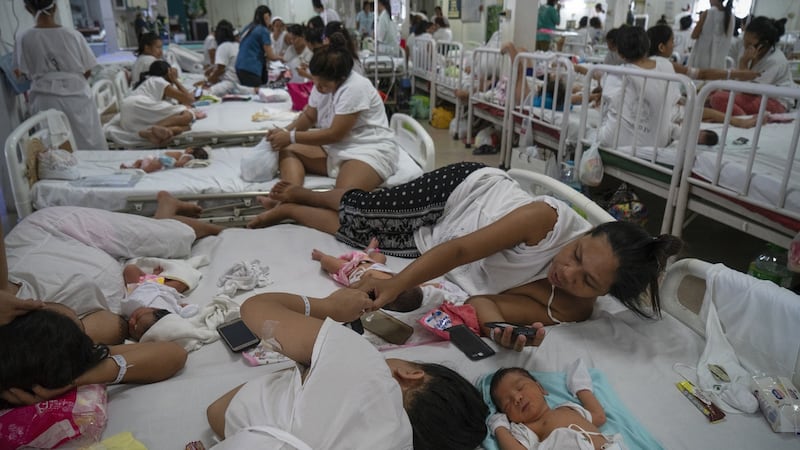

WARD FOUR AT Fabella Hospital in Manila has been dubbed the busiest maternity ward on the planet. It's a place of joy and tears, giggles and exhaustion, and constant, ceaseless activity. There are 133 babies on the ward today, most of them born within the last 48 hours.
Ranks of double beds are placed next to each other, with only narrow walkways between each row. Sitting, lying or sleeping on each bed are four mothers in identical spotless hospital gowns, and four tiny babies. Women curl in the foetal position, breastfeed their babies (formula is forbidden), fiddle with their mobile phones, change nappies, swap stories and eat lunch, all in a tiny, shared space.
“749, you have a visitor!” Nurses use a megaphone to call patients forward, or tell them they have visitors waiting. There’s no space to allow visitors into the ward. Fabella may be overcrowded, but it is clean and, most importantly, it is free. Most patients are from the poorest of the poor.
Arlyn Ligaya is breastfeeding her sixth baby. One was stillborn. “One lives with my father, two with their father, and three now with me. This baby is with a new partner. I wasn’t taking any pills”. But she’s decided that Arnan Ghrie will be her last baby, and is going to get an implant.
When did you decide? I wonder.
She laughs. “The moment I found out I was pregnant again”.
Nearly every family here loses one child before the age of five, usually through dehydration. They have five, six children and no time or money to take care of them
Ligaya, who is 27, had her first baby when she was still at school. “I still graduated though,” she says. Teenage pregnancy is particularly high in the Philippines, a legacy of non-existent sex education. Fabella hospital has now taken a proactive stance on contraception, and there is even a family planning desk in a corner of Ward 4.
"All post-partum women are counselled for family planning," says consultant obstetrician and gynaecologist Dr Diana Rose Cajipe. "Then they are scheduled for an IUD, an implant or whatever method they choose."
Under the UN Sustainable Development Goals, the Philippines has committed to reducing maternal mortality – there were 115 deaths per 100,000 births in 2015, although the target had been 52 (compared with eight in Ireland). They brought in a Reproductive Health Law in 2012, which provides for access to free family planning. One of the main arguments from campaigners was that free contraception would help reduce the incidence of unsafe abortion. It's estimated that about 1,000 women die due to botched abortions every year in the Philippines.
However, the law’s implementation was repeatedly delayed, with a supreme court case challenging its constitutionality, and a Catholic organisation obtaining a temporary restraining order against contraceptive implants and other products, which was only lifted last year.
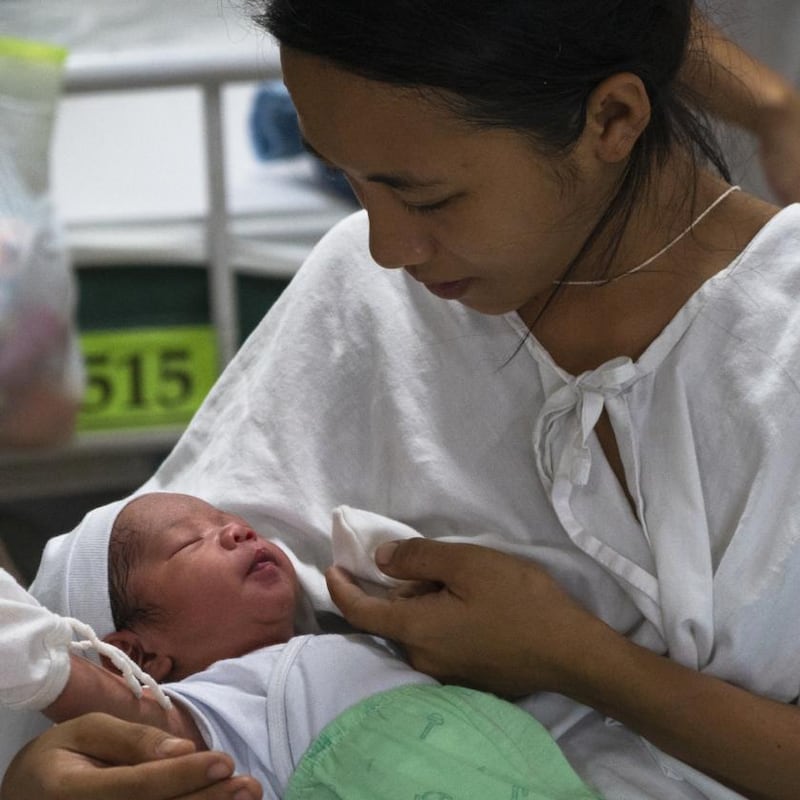
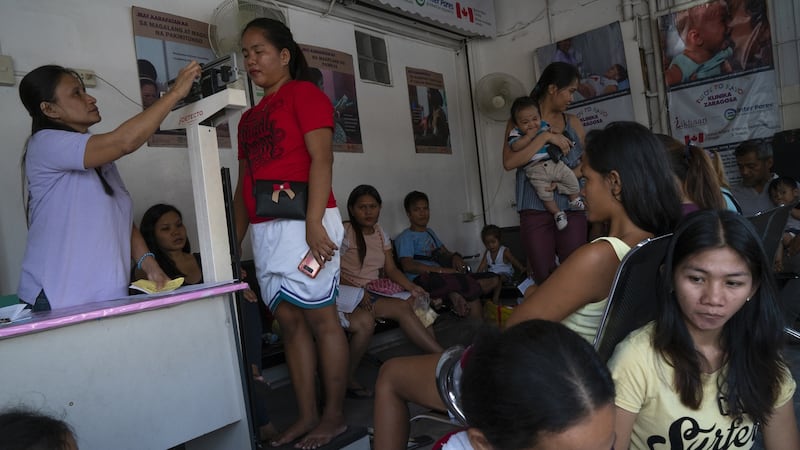
NOW THAT THEY are available though, some Filipinas are voting with their feet, and if necessary their bus fares. We jump in a jeepney – a uniquely Filipino mode of transport – to Tondo, a slum near Manila Bay, where shacks are mounted haphazardly on top of each other. Our jeepney is festooned with exhortations, including "God Bless Us", which seems appropriate, as we race through a junction, missing a tricycle carrying garbage by inches.
At a Likhaan family planning clinic, 19-year-old Judy May Aguilar has made an even longer journey, four hours by bus from the provinces, in search of an implant, which isn't available where she lives. She had her first baby, a boy, at 17 and has just had her second, a girl.
“I woke up at 4am to get here,” she says. “My aunt says it’s a good service. It’s my first time to use family planning”.
After a consultation, a nurse gives her a local anaesthetic and inserts the implant into Aguilar’s arm. She winces, but is soon smiling.
“The anaesthetic hurt more than the implant,” she says. “I like the idea because it’s for three years. I would forget to take the pill”.
The clinic receives supplies from the government, and also refers patients to Fabella Hospital for ligation and vasectomies. It also has antenatal care and a birthing unit.
Likhaan is making inroads in the areas where it works, but most poor people in the Philippines only have access to public clinics, where family planning services may only be offered on one day a week, or one day a month, and in rural areas maybe only once a year.
Mothers and children are queuing for check-ups. Tired women in shorts, T-shirts and flip-flops, with scrunchies in their hair, wait patiently. The doors open and they rush in
A tricycle ride to a different part of Tondo reveals a different level of understanding of family planning. Outside a public clinic, mothers and children are queuing for check-ups. Two stroke engines belch fumes, and tiny, half-starved kittens peek over the side of a rubbish bin. Cauldrons of porridge-like broth simmer on stoves. Tired women in shorts, T-shirts and flip-flops, with scrunchies in their hair, wait patiently. The doors open and they rush in, queuing up again on orange plastic chairs.
A woman holds her four-month-old baby. “Her name is Roberta,” she says proudly. “It’s an Italian name.” The 39-year-old woman has seven children, the oldest just 12 years of age. She doesn’t use contraception. “They’ve told me I shouldn’t have any more kids. But I’m breastfeeding for now.”
The belief that you won’t get pregnant while breastfeeding is just one example of a lack of knowledge and understanding of family planning, with some devastating consequences.
“Nearly every family here loses one child before the age of five, usually through dehydration,” says one of the centre’s GPs. “They have five, six children and no time or money to take care of them. We offer family planning, but the take up is not high. Some are afraid of possible side effects, others just don’t know about it”.
She also sees other results of this failure to use contraception. “They won’t say it to me directly, but I suspect several of my patients have had induced abortions. They’ve come in bleeding. One was a patient who was going abroad to work; she didn’t want to be pregnant. I referred her to hospital for a D and C [dilation and curettage, procedure after miscarriages and botched abortions]. Another patient wouldn’t go to hospital. I found out later that she died”.
Despite encountering these cases and doing her best to help, the doctor (who did not want to be named) does not believe abortion should be legalised.
“It’s not a good practice, not only as a person but as a Christian. I want to inform them of the possibility of complications, and the spiritual setback. If they have an abortion they will be haunted by it.”
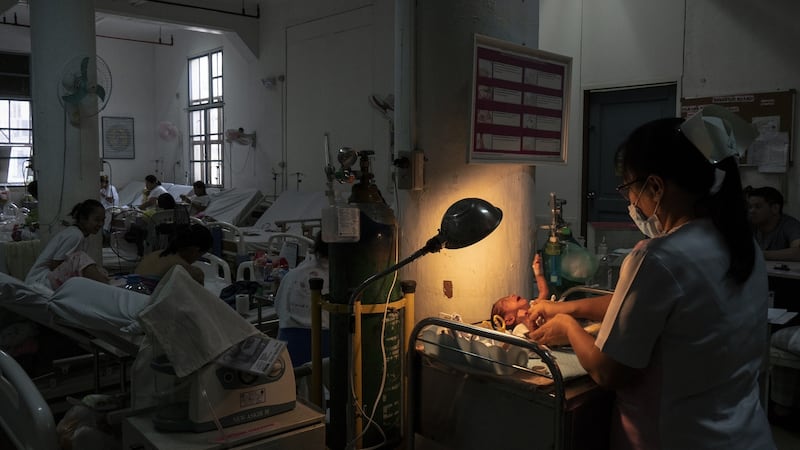
OPPOSITION TO ABORTION is deeply ingrained. Colonised by the Spanish for nearly 400 years, the Philippines is the most Catholic country in Asia, and the only country in the world where divorce is illegal.
On All Saints Day, Quiapo church, the minor basilica of the Black Nazarene, is standing room only. Huge fans whir ineffectively overhead. The congregation ebbs and flows, some stopping to touch statues whose paint has been worn away by the reverent caresses of thousands of worshippers.
Outside the open church doors is a market where the scent of sampaguita, Philippine jasmine, fails to mask the stink of dried fish. Stallholders encourage me to buy a replica of the Black Nazarene, or to light one of the many coloured candles that promise a job overseas, money, or love.
I’m here on a different mission, to find out just how easy it is to procure an abortion, within 10 metres of one of Manila’s biggest churches.
“Abortion is actually an open secret in this country,” according to Marevic Parcon of the Philippines Safe Abortion Advocacy Network, or Pinsan. “Everyone knows where to go, to Quiapo or Baclaran,” another basilica on the southern edge of the city.
The stalls selling pamparegla, a bitter herb, are the ones to look for. I try to engage a few stallholders in conversation, but they are wary. Within minutes I get chatting to a dark haired woman in her forties. I ask her what pamparegla is for.
“Abnormal menstruation,” she says, smiling.
“What about delay?” I ask. This is the Filipino euphemism for unwanted pregnancy.
“You don’t need to take pamparegla for that,” she says. “You can take Cytotec if you are delayed”.
Cytotec (generic name misoprostol) is a drug more commonly used to treat ulcers, but used here for “medical abortion”. It has been banned in the Philippines but seems to circulate freely in Quiapo.
“How much?”
“Depends on what stage,” she says. If you are one month gone, then 10 tablets. If two, maybe 12. 250 pesos per tablet (about €4).
“Oh Sacrament Most Holy” drifts out into the street, and I look around, wondering about the police, and whether what she is selling is real or fake. Elsa reaches into a black plastic bag hanging from her stall and takes out a single blister pack, the purple lettering spelling out Cytotec clearly visible.
“No problem with police,” she says (there are reports that the stallholders pay bribes).
Why do you do it? I ask
“Filipinos have too many children,” she says. “Sometimes they can’t cope.”
What if it goes wrong? Cytotec leaflets specifically warn about the risks of miscarriage. The product is not designed to be an abortion pill.
“They can text me for instructions,” she says, putting the blister pack back into the bag.
Not everyone goes to Quiapo of course. Those who can afford it can fly to Hong Kong or Singapore, but this is not an option for the vast majority of Filipinas. There are also private underground clinics that carry out surgical abortions, but these are expensive and difficult to access without connections, so some resort to backstreet abortionists, with all the risks that entails.
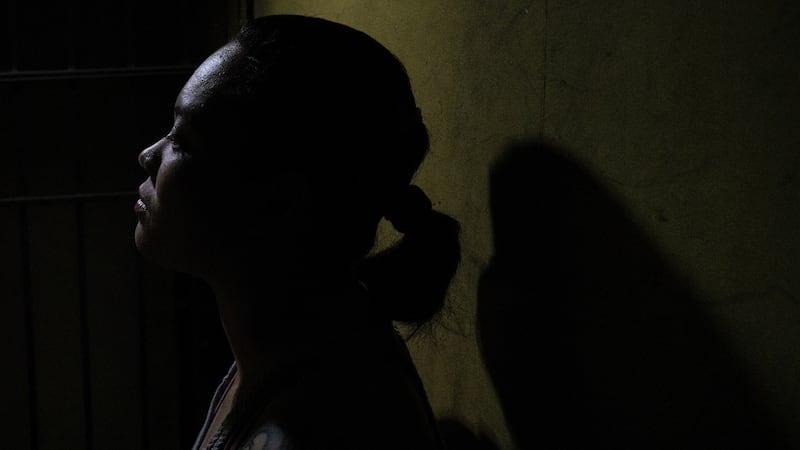
I thought I was going to die. She did it with her bare hands, no anaesthesia, no sterilisation
Late one evening I meet Steph at the entrance to an alleyway, just before she goes on the night shift at a call centre. We climb three steep flights of stairs and sit on a balcony outside her small flat in the warm Manila night.
“I thought I was going to die. She did it with her bare hands, no anaesthesia, no sterilisation.”
Steph became pregnant at 16, and her mother made an arrangement with an older woman.
“I stayed with her all night. She gave me pills, put something in my vagina, told me to watch a movie. From time to time she would press my belly. Finally the pain became severe, and she took it out. She told me not to look so I wouldn’t remember.”
Steph had two more abortions, buying pills at Quiapo, but in one case they didn’t work. “ I went to a ‘clinic’. There were a lot of shoes and slippers outside. They told me normal is 5,000 pesos, painless is 10,000. It was really painful. One girl held my hand, another pressed my tummy. She used tools.”
Steph holds out her forearms, tattooed with the names of the two babies she has had since. “I have names for the other three too, and I sometimes wonder what my life would have been life if I kept them. I still pray for them”.
But she has no doubts about the need for safe abortion. “It’s really dangerous. It should be legalised.”
Campaigners know they face an uphill struggle. Their first tasks, as they see it, are to defend the Reproductive Health Law, press for its implementation and financing, and destigmatise contraception and abortion.
"We know it's going to be a long hard battle, just like in Ireland, " says Parcon. "When we talk openly about it among the urban poor there's no question about it in the case of saving the life of the mother, and in cases of rape and incest. But beyond that, if you say abortion should be liberalised, you'll be called an immoral person".
The Filipino campaigners have kept a close eye on events in Ireland, particularly the passing of the Repeal referendum in May this year. “We call ourselves twins, we’re both predominantly Catholic,” says Tesorio of Likhaan. “We were cheering when the result came in. We cried, actually.”
Pinsan invited the Together for Yes spokesperson Sarah Monaghan to speak at a conference in the Philippines in August to learn from the Irish experience. "What was impressive was the organising and the volunteers, and especially getting people to speak out", says Parcon. "That's what we are trying to emulate. But we know for a fact they [the Catholic Church] won't take this, there will be full-blown opposition".
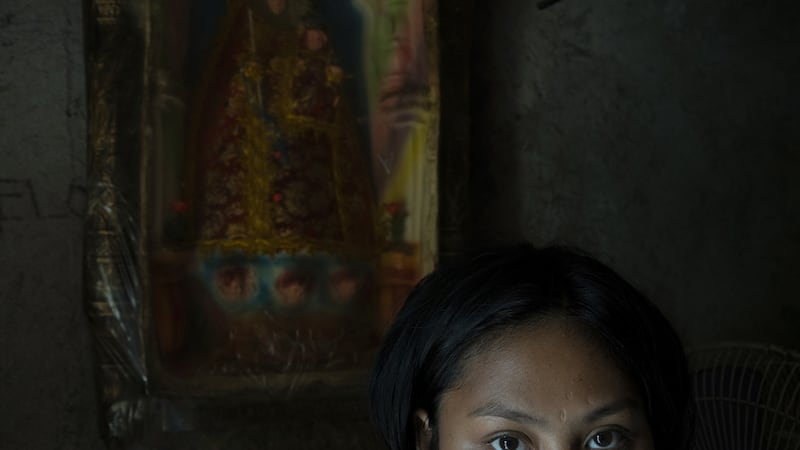
BACK IN MARABON, a circular drying rack whirls in the breeze outside Zia's tiny home, carrying a turquoise-trimmed pink babygro and a pink bib. "I got pregnant again when I was 18." she says. "This time my parents wanted me to keep it. They were afraid I would have an abortion again".
By then Zia’s boyfriend, who now lives with her, was earning 300 pesos (€6) a day working in construction, so she went ahead with the pregnancy. She sometimes thinks about what happened when she was 14.

“Of course I have some regrets, but when I think about it, I couldn’t have looked after a baby at that age, given it a good life. Abortion should be legal, it shouldn’t be a secret and people shouldn’t be afraid.”
This article was supported by a grant from the Simon Cumbers Media Fund














